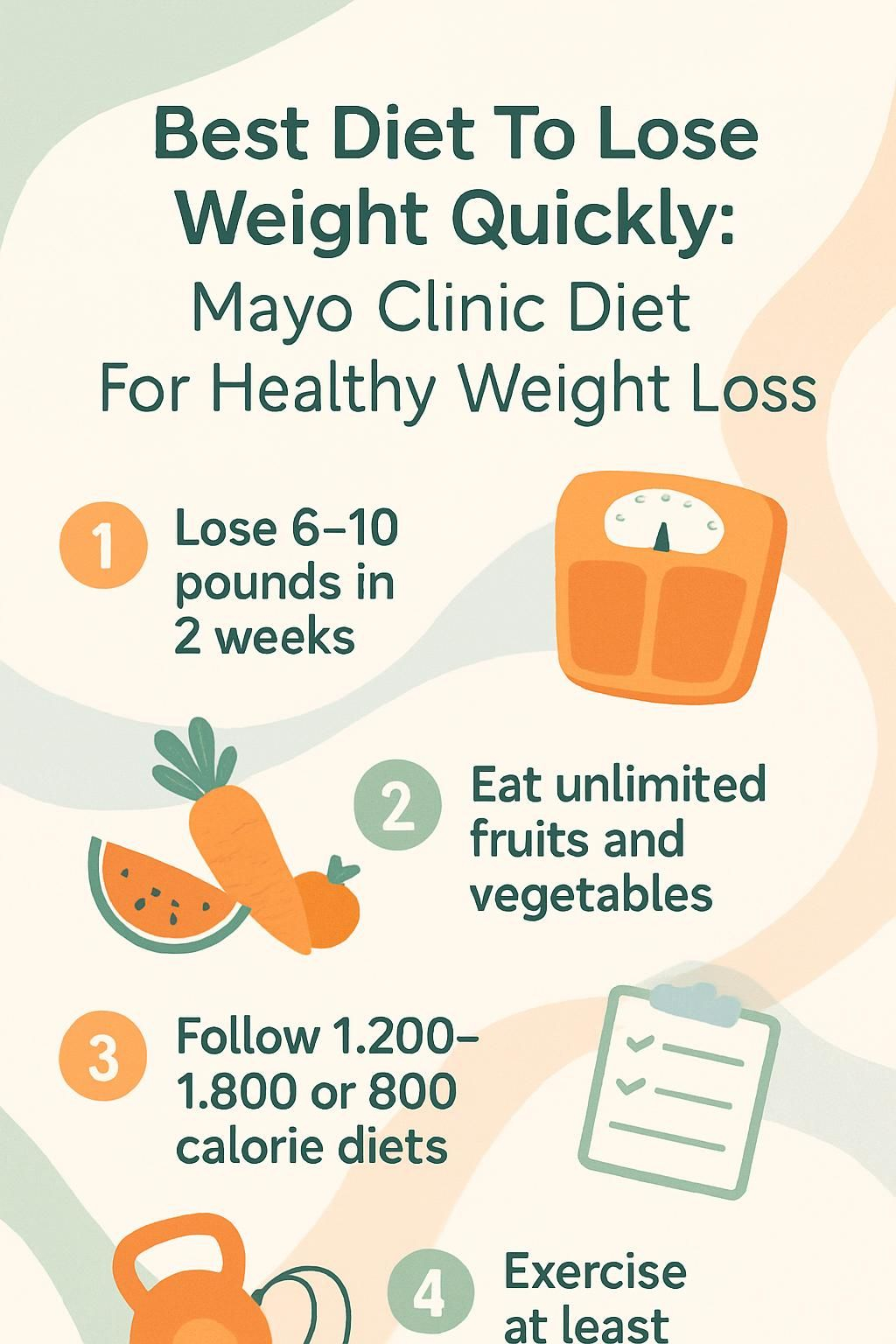Best Diet To Lose Weight Quickly: Mayo Clinic Diet For Healthy Weight Loss
Our Nutrition Assistant AI Suite will transform your body. You will lose fat, get toned, and build muscle. Gain confidence and optimal health.
If you struggle to lose weight and want a safe way to slim down fast, you are not alone. Many rapid weight loss plans promise quick results, yet few support long-term health. The Mayo Clinic Diet offers a clear path that helps with fast progress and steady weight loss maintenance. This article shows how the program works, how it differs from fad diets, and how to use its diet strategies to reach your goals.
Keep reading to learn smart ways to start losing excess weight today.
Key Takeaways
- The Mayo Clinic Diet can deliver a quick start, often 6 to 10 pounds in two weeks, using a structured plan with unlimited fruits and vegetables.
- This eating plan avoids cutting food groups. It uses the Healthy Weight Pyramid to emphasize fiber-rich foods and portion control for lasting success.
- Medical experts created options such as Low-Calorie Diets, 1,200 to 1,800 calories, and Very Low-Calorie Diets near 800 calories, which require supervision.
- At least 30 minutes of daily physical activity supports weight loss, protects muscle, and lowers risks linked to type 2 diabetes or heart disease.
- Research summarized by groups like the CDC links these habits with lower risk for obesity-related illnesses including high blood pressure, cancer, stroke, and sleep apnea[^1][^2].

What is the Mayo Clinic Diet?

The Mayo Clinic Diet is a structured diet plan that supports healthy weight loss and long-term weight maintenance. This approach uses evidence-based steps to help you lose weight safely and build lasting habits.
What is the Mayo Clinic Diet?
Created by weight-loss experts at Mayo Clinic, this program helps you lose weight safely and keep it off. You focus on simple lifestyle changes that fit real life and stick over time.
Medical professionals designed the eating plan for daily living, so you do not need to cut entire food groups or count every calorie. You can eat as many fruits and vegetables as you want each day. The Healthy Weight Pyramid guides choices toward whole grains, lean protein, and healthy fats.
Many people find it easier than strict plans that track points or ban foods. The program covers both losing excess body weight and maintaining a healthy weight with practical advice for nutrition and daily habits.
Why is the Mayo Clinic Diet a sustainable weight loss solution?
The Mayo Clinic Diet supports weight loss maintenance by building habits you can use for life. You center meals on fruits and vegetables, which add volume and fiber without many calories.
Instead of harsh calorie cuts, the plan encourages enjoyable changes in eating patterns. Helpful tools include journals, meal planners, and trackers that keep you accountable each day. The meal plan is flexible, whether you prefer a plant-based diet or include dairy and fish. Medical oversight is available for safety if you have health conditions such as type 2 diabetes or hypertension.
One reader shared that the clear guidance, variety, and support led to a 10 pound loss within several weeks while still enjoying everyday foods.
Sustainable weight loss depends on what you eat and how those habits fit your daily life.
This approach works for people trying to lose weight quickly or maintain long-term results because it avoids short-term rules and builds healthy routines backed by research.
How the Mayo Clinic Diet Works
The Mayo Clinic Diet offers a healthy diet plan that relies on proven strategies. Its approach helps you adopt sustainable habits for better health and steady weight reduction.
How does the Mayo Clinic Diet focus on healthy food choices?
You start with nutrient-dense foods like vegetables, fruits, beans, whole grains, nuts, and fish. These foods are rich in fiber and vitamins while staying low in calories. Unlimited fruits and vegetables help you feel full without weight gain. Sweets are limited to 75 calories per day to keep sugar in check.
Balanced nutrition sits at the core of this diet. No food group is removed. The Healthy Weight Pyramid guides you to eat the most from the base, mainly fruits and vegetables, and less from higher-calorie foods like meats or added fats. Mediterranean-style ideas, such as overnight oats or Tuscan white bean soup, support heart health and long-term success. You also get tips for dining out so you can follow the plan at restaurants or social events.
What is the Mayo Clinic Healthy Weight Pyramid?
The Mayo Clinic Healthy Weight Pyramid is a visual guide for balanced eating and weight loss. The base is fruits and vegetables, and these should make up most of your daily intake.
The pyramid encourages at least five servings a day for fullness with fewer calories. Portion control matters. Higher layers include lean proteins, grains, healthy fats, and small amounts of sweets or treats. Instead of strict calorie counting, the pyramid helps you choose the right mix of food groups in portions that fit your goals. It works across calorie levels and fits both low-calorie and very low-calorie approaches.
Simple swaps like adding vegetables at lunch and dinner can help you maintain a healthy weight after weight loss. The pyramid serves as the backbone for meal planning throughout the program.
Eating mostly plants helped me keep extra weight off without feeling hungry.
Next, see how the Mayo Clinic Diet builds lasting lifestyle changes alongside smart food choices.
How does the Mayo Clinic Diet encourage lifestyle changes?
You build long-term habits through a two-phase approach. In the LOSE IT phase, you target quick weight loss for two weeks by adopting five healthy habits and breaking five unhealthy ones. You then move to the LIVE IT phase to practice these habits daily and maintain results. The plan also suggests five bonus habits that improve well-being beyond weight loss.
Daily physical activity is central. Aim for at least 30 minutes every day and try to add movement, such as taking stairs or walking more often. Digital tools make it easy to track meals, exercise, and progress. You also practice mindful eating skills like planning meals ahead and using portion control. These steps support steady weight loss and help you maintain your new weight.
Key Principles of the Mayo Clinic Diet
These core ideas help you make smart food choices and support lasting results. They work well if you are trying to lose weight and manage obesity.
Why should you eat more fruits and vegetables?
You can eat unlimited fruits and vegetables on the Mayo Clinic Diet. This helps you feel full while keeping calories low. High-fiber produce supports digestion and increases satiety, which makes it easier to reduce total calorie intake.
The plan emphasizes at least five portions per day. Sample menus often put vegetables on half your plate at main meals. The Healthy Weight Pyramid places fruits and vegetables at the base to help you use them at every meal. Eating more fiber ties to a lower risk for obesity, cardiovascular disease, stroke, type 2 diabetes, colorectal cancer, breast cancer, and major depressive disorder in large reviews of research. If you increase fiber quickly, sip water to ease any digestive changes.
How can you limit sugar and unhealthy fats?
Filling your plate with whole foods leaves less space for sweets or rich sauces. Limit sweets to 75 calories per day. Swap sugary drinks for water or unsweetened tea. This simple change can cut hundreds of empty calories.
Choose low-fat, low-sugar dairy like skim milk or plain Greek yogurt. Use unsaturated fats such as olive oil, and measure oils to control calories. Eat fish, especially salmon or sardines, twice a week in place of red meat, which is higher in saturated fat. Reading labels helps you spot added sugars and hidden fats. Whole grains are a safer bet than highly processed products.
Processed foods near the top of the pyramid often have extra sugars and unhealthy fats. Skipping them supports weight loss maintenance. Aim for carbohydrates from whole grain sources so about one third of your plate comes from carbs while you boost dietary fiber.
What are effective portion control and mindful eating strategies?
Once you limit sugar and unhealthy fats, you can improve results with portion control and mindful eating. These habits lower calories, support fullness, and protect long-term progress.
- Use smaller plates and bowls to manage serving sizes. This visual cue helps you eat less without feeling deprived.
- Measure oils with a spoon or scale. Extra oil adds hidden calories that slow progress.
- Fill half your plate with vegetables like broccoli or carrots to increase volume for fewer calories while boosting fiber.
- Weigh foods with a kitchen scale. Accurate portions improve energy balance and weight loss over time.
- Serve portions in the kitchen instead of at the table to limit second helpings.
- Skip screens while eating. Focus helps you notice hunger and fullness cues.
- Keep a food journal or use an app. Tracking reveals eating patterns that affect your weight.
- Chew slowly. Research suggests that slower eating can increase satisfaction with less food.
- Prepare snacks like sliced vegetables or hard-boiled eggs. Ready-to-eat options make healthy choices easier.
- Limit high-calorie condiments like creamy dressings. These can make a healthy meal much higher in calories.
These steps help you cut calories, keep muscle, and enjoy nutrient-rich foods each day.
Types of Diet Approaches in the Mayo Clinic Diet
The Mayo Clinic Diet uses several approaches that can help you lose weight quickly and safely. Understanding each method helps you choose the plan that fits your life.
What is a Very Low-Calorie Diet (VLCD)?
A Very Low-Calorie Diet, or VLCD, limits intake to about 800 calories per day. Doctors often use this approach for adults with obesity who need rapid weight loss for medical reasons such as lowering blood pressure or reducing type 2 diabetes risk. Most VLCDs use fortified meal replacements, such as shakes, soups, and bars.
Research shows VLCDs can lead to about 3 to 5 pounds of loss per week in the short term. Medical supervision is essential. These diets are not safe for children, teens, pregnant women, or many older adults. Most programs do not extend beyond 12 weeks without close follow up, since fast calorie cuts affect your body in many ways. Evidence supports VLCDs for specific cases where rapid loss reduces major health risks.
What is a Low-Calorie Diet (LCD)?
A Low-Calorie Diet, or LCD, usually means 1,200 to 1,500 calories for women and 1,500 to 1,800 for men. Many people prefer LCDs because they are safer than VLCDs and still effective. LCDs lead to steady weight loss without cutting food energy too low.
You can use meal replacements, regular foods, or a mix. This flexibility improves adherence and makes maintenance easier. Doctors often suggest LCDs when you have obesity-related conditions like diabetes or high cholesterol. Children and teens should only follow an LCD under medical guidance.
How does Time-Restricted Eating work?
Time-Restricted Eating shifts focus from what you eat to when you eat. You consume your daily calories within a set window, such as 10 am to 6 pm. Foods are not restricted by type, but the eating hours are limited.
Short-term studies suggest this pattern may help with weight loss and maintenance. Results can be modest unless paired with a nutritious diet like the Mayo Clinic Diet or a Mediterranean-style plan. An eight-hour window can reduce late-night snacking and improve portion control. Time-Restricted Eating does not suit everyone, especially if you take certain medicines or have medical conditions. Seek supervision if you have type 2 diabetes or other concerns.
What is Intermittent Fasting and how is it used?
Intermittent fasting alternates periods of eating and fasting to reduce total calories. The 16/8 method uses a 16 hour fast and an 8 hour eating window. The 5:2 method uses two very low-calorie days per week and normal intake on the other days. These patterns can lead to modest weight loss, especially when paired with whole foods.
Early research suggests intermittent fasting may improve blood sugar or sleep apnea in some adults. It is not advised for children, teens, pregnant women, or people with certain medical concerns unless supervised by a clinician. Many people find adherence challenging due to hunger or schedule changes, so plan carefully and adjust as needed.
Benefits of the Mayo Clinic Diet
The Mayo Clinic Diet provides health benefits along with weight loss results. These changes help many people reach their goals and keep progress going.
How does the Mayo Clinic Diet promote long-term weight loss?
You lose weight and keep it off by building new habits. Start with the LOSE IT phase where many people drop 6 to 10 pounds in two weeks. In the LIVE IT phase, weight loss often settles at about 1 to 2 pounds per week until you reach your goal.
This success comes from focusing on whole foods from all food groups and relying on unlimited fruits and vegetables for fullness. Portion control and mindful eating help prevent overeating. Track your progress with simple tools. Gradual, steady changes lower the odds of regaining weight compared to fad diets.
How does it improve overall health and well-being?
Selecting nutrient-rich foods can raise energy and reduce fatigue. A balanced mix of fruits, vegetables, lean proteins like eggs, and whole grains supports digestion and hydration. The diet recommends 6 to 8 cups of fluids daily. High-fiber meals may change digestion at first, then usually improve regularity.
Healthy habits can lower stress levels and lift mood. Exercise is a key part of the plan. It improves heart health and supports long-term goals. Many people report better sleep after starting this lifestyle, which can ease symptoms of sleep apnea. A simple routine of daily walks plus mindful eating helps many feel focused with fewer cravings.
How does it reduce the risk of chronic diseases?
Following the Mayo Clinic Diet can lower risk for type 2 diabetes, heart disease, and high blood pressure. You eat at least five portions of fruits and vegetables daily to support cancer prevention and better health. The plan includes fish twice a week, including salmon or mackerel, to improve heart health. Limiting processed foods and unhealthy fats helps reduce cholesterol.
Whole grains, nuts, beans, and healthy fats protect your heart. High-fiber foods keep you full and reduce risks tied to obesity such as gallbladder issues. As extra weight comes off, strain on organs drops and long-term health can improve.
The Role of Exercise in the Mayo Clinic Diet
Daily physical activity supports energy balance and helps you lose excess weight. Movement also boosts mood and improves sleep.
Why is daily physical activity important?
Regular exercise is a key part of any diet plan, including the Mayo Clinic Diet and even the free NHS weight loss plan. Aim for at least 30 minutes per day to increase calorie burn. Add simple tasks like walking, using stairs, or resistance moves to maintain muscle while you lose fat.
Exercise lowers risk for chronic diseases like diabetes, dementia, and heart disease. It also supports cardiovascular health. Many people find that daily walks keep motivation high and help manage hunger during lower-calorie phases. Build these habits early to protect results. Check with a healthcare provider before starting new activities if you have medical conditions or are pregnant.
What are some beginner-friendly exercise plans?
After understanding why daily movement matters, you can start with simple plans that are easy to keep. These options need little or no equipment and support long-term success.
- Walking is a safe starting point. Aim for 30 minutes daily to improve heart health and encourage fat loss.
- Do resistance moves like squats, wall pushups, or lunges. These help prevent muscle loss during weight reduction.
- Try at-home activities such as chair stands or step-ups. These fit all fitness levels and require minimal gear.
- Increase incidental movement by taking stairs instead of elevators. Small changes add up across the week.
- Use tracking tools or the Mayo Clinic app to monitor steps and time. Visible progress boosts motivation.
- Build endurance gradually by increasing duration or intensity weekly. Slow progress reduces injury risk.
- Choose low-impact activities like cycling or swimming if you want variety or have joint concerns.
Exercise supports any diet for weight loss, including the DASH diet and low-carbohydrate plans. Pick activities you enjoy so you can keep the habit for the long haul.
Sample Daily Menu for the Mayo Clinic Diet
A sample menu shows how to build balanced meals that help you lose weight and feel satisfied. Mix and match ideas to fit your taste and schedule.
What are healthy and balanced breakfast options?
Starting your day with a healthy breakfast can improve energy and control hunger. The Mayo Clinic Diet favors high-fiber, low-calorie choices that keep you full.
- Make overnight oats with berries and a pear for whole grains, fiber, and antioxidants.
- Choose fresh fruit each morning for vitamins and satiety. Oranges, apples, or bananas work well.
- Use whole grains like steel-cut oats instead of sugary cereals to avoid spikes and crashes.
- Skip pastries and sweet cereals to prevent midmorning energy dips.
- Include lean protein such as Greek yogurt or eggs to support fullness and muscle.
- Add nuts or seeds in small portions for healthy fats that tame appetite.
- Drink water or unsweetened tea instead of juice or soda to limit calories.
- Prep ahead for busy mornings. Overnight oats are ready to grab and go.
- For a plant-based option, pick soy or pea protein yogurt with added calcium.
What are nutrient-dense lunch ideas?
After a solid breakfast, choose a lunch that keeps you satisfied and supports your goals. Aim for meals with fiber, protein, and color.
- Tuscan white bean soup with pesto provides protein and fiber. Use fresh herbs for flavor while limiting added fats.
- Build salads with leafy greens, tomatoes, cucumbers, beans, and grilled chicken or fish. Whole ingredients keep calories in check.
- Make a grain bowl with quinoa, roasted vegetables, and turkey or tofu. Add avocado for healthy fats and satiety.
- Cook lentil stew with carrots, spinach, and onions. Lentils are rich in protein and fiber that curb hunger.
- Use whole grain wraps with hummus, lettuce, shredded carrot, peppers, and beans for balance without heaviness.
- Pair vegetable soup with a piece of fruit to increase volume without many calories.
- Download the free NHS weight management resources for more balanced lunch ideas that fit your needs.
- The Mayo Clinic Diet favors simple meals with minimally processed foods to reduce sugar and unhealthy fats.
These lunches fill you up with fewer calories while delivering vitamins, minerals, fiber, and lean protein.
What are filling yet low-calorie dinner choices?
Now focus on dinners that satisfy and stay easy on busy nights. The goal is fullness, flavor, and control of calories.
- Sheet-pan roast chicken with broccolini, onion, and tomatoes provides lean protein and colorful vegetables. Roasting keeps calories lower while building flavor.
- Make stir-fries with skinless chicken or tofu and vegetables like peppers, broccoli, and carrots. Season with herbs and spices instead of oil-heavy sauces.
- Cook hearty vegetable soups with beans or lentils for fiber and protein. Batch cook for quick meals.
- Bake salmon or grill white fish with steamed green beans or Brussels sprouts. Fish offers omega-3 fats with little saturated fat.
- Build Mediterranean-style grain bowls with quinoa or brown rice. Top with greens, tomatoes, cucumbers, chickpeas, lemon juice, and a small amount of feta.
- Serve roasted sweet potato halves topped with salsa and black beans. This fiber-rich meal helps curb night cravings.
- Prepare big salads with lettuce, grilled chicken, tomatoes, cucumber, sunflower seeds, and a light vinaigrette. Measure dressing to control calories.
- Make omelets with spinach, mushrooms, tomatoes, and reduced-fat cheese. Use a nonstick pan to limit oil.
- Season with basil or rosemary and garlic powder to reduce the need for extra salt or heavy sauces.
- Use smaller plates at dinner to limit portions. This simple trick reduces overeating after long days.
- Pick chilled fruit salad for dessert. It satisfies a sweet tooth and supports steady blood sugar.
A filling dinner can be low in calories when you rely on produce, lean proteins, and careful portions.
What are smart snack options to curb hunger?
Even with a solid dinner, a snack can keep your energy steady. Choose options that align with your plan and reduce cravings.
- Snack on one cup of sliced bell peppers. You get about 30 calories and fiber.
- Enjoy one banana for natural sweetness and about 3 grams of fiber.
- Make fruits or vegetables your main snacks to limit processed foods high in sugar and unhealthy fats.
- Plan snacks ahead so you are less tempted by high-calorie treats.
- Keep daily sweet intake under 75 calories to leave room for a small treat.
- Drink water, unsweetened tea, or black coffee at snack time to tame hunger.
- Choose produce-based snacks like carrot sticks or apple slices to avoid excessive hunger later.
- Avoid skipping snacks if it leads to overeating at the next meal.
- Practice mindful eating. Sit down, chew slowly, and stop at comfortable fullness.
- Email your meal plan or shopping list to yourself for easy reference during the week.
Smart snack choices help curb hunger without adding empty calories, which supports steady progress.
Potential Risks and Considerations
Every diet makes demands on your body. Understanding possible risks helps you choose safely and plan ahead.
How should the diet be adjusted for pre-existing health conditions?
You may need adjustments if you have specific health needs. A rapid rise in fiber can cause mild digestive changes. Increase fiber gradually if you have a sensitive stomach or irritable bowel syndrome. People with diabetes should focus more on vegetables than fruit to manage blood sugar. Natural fruit sugars still count toward carb intake.
Children, teens, older adults, and pregnant women should use this plan only with medical guidance. People with digestive diseases may need to avoid some raw produce at first. Your calorie level and food choices must match your medical history for safety and better outcomes. Check with a clinician if you are unsure how to tailor the plan.
Why is consulting a healthcare professional important?
Medical advice protects your health and safety. Rapid weight loss can raise risks if not managed well. Losing more than 1 to 2 pounds per week may cause muscle loss, dehydration, bone density loss, gallstones, gout, fatigue, constipation, diarrhea, or nausea. If you have diabetes or heart disease, oversight is essential before changing your diet or exercise.
A trained provider can adjust your plan for safer and more effective results. Expert guidance lowers the chance of complications and supports long-term success. Many people regain lost weight without professional support. Working with a clinician improves your odds of steady, healthy results.
Tips for Success with the Mayo Clinic Diet
Small steps matter. Consistency and planning make your new habits easier to maintain over time.
How can meal planning and preparation improve success?
Meal planning and prep play a major role in reaching your goals. These habits support healthy choices and reduce impulse eating.
- You boost adherence when you map out meals in advance, which limits last-minute decisions.
- Prep enables portion control since you can use smaller dishes or measuring tools to set servings.
- Planning helps you build grocery lists from the Healthy Weight Pyramid, which guides nutritious shopping.
- Ready snacks like cut vegetables or portioned nuts reduce the pull of less healthy options.
- Keeping a food journal highlights patterns and areas for improvement.
- Using Mayo Clinic sample menus adds structure and variety to your week.
- Including whole grains and a mix of vegetables at each meal increases fiber for fullness.
- Planning supports mindful eating because each meal has a clear purpose.
- Setting aside one day for prep can steady your routine during busy weeks.
With a plan in place, you remove guesswork and make the healthy choice the easy choice.
What are ways to stay consistent with lifestyle habits?
Consistency drives results. Practical strategies and tools keep you motivated and moving forward.
- Set realistic, achievable goals for weight and daily activity to stay encouraged.
- Track food and exercise with journals or apps. Self-monitoring improves long-term success.
- Build routines that fit your life. Enjoyable habits are easier to keep.
- Get at least 30 minutes of activity daily, even if it is walking or chores.
- Check progress weekly with a simple tracker so you can celebrate wins and adjust quickly.
- Use support networks or Mayo Clinic resources to increase accountability.
- Adapt as challenges arise. Flexible planning stops setbacks from ending your progress.
These steps improve consistency and support better health outcomes over time.
How do you track progress effectively?
Tracking keeps you honest and helps you course-correct fast. Use simple tools and a routine check-in.
- Use the Mayo Clinic Diet trackers and electronic journals to enter food, activity, sleep, and energy.
- Log every meal and snack. Note portion sizes, and weigh foods for accuracy.
- Track both exercise sessions and daily steps to spot improvements.
- Record your starting weight. Many people lose 6 to 10 pounds in the first two weeks, then 1 to 2 pounds weekly.
- Monitor hydration by recording daily water intake.
- Note changes in energy, sleep, mood, and well-being, since progress is more than the scale.
- Review meal logs to find patterns that slow progress and adjust quickly.
- Update goals as needed. If weight loss slows, adjust calories or activity based on Mayo Clinic guidance.
- Consult a healthcare professional before major changes if you have pre-existing conditions.
Clear records make your progress visible and help you stay consistent with healthy habits.
Frequently Asked Questions
You may have questions about the Mayo Clinic Diet and weight loss. These answers offer clarity before you begin.
Can you lose weight quickly with the Mayo Clinic Diet?
Yes. In the LOSE IT phase, many people lose 6 to 10 pounds in two weeks using safe, evidence-based steps rather than extreme tactics. After that, weight loss often slows to about 1 to 2 pounds per week. Quick early results can boost motivation and help you stay on track.
One user followed the LOSE IT phase and lost 8 pounds in two weeks while eating balanced meals and feeling energized.
Is the Mayo Clinic Diet suitable for everyone?
The Mayo Clinic Diet is safe for most healthy adults. Children, teens, pregnant women, and older adults should only use it with medical guidance. People with diabetes or other medical concerns should ask a clinician first because large amounts of fruit and some starchy vegetables can affect blood sugar.
If you have digestive issues, you may need to modify food choices. If you have an eating disorder, work only with a provider. Mayo Clinic resources are helpful, but they do not replace advice from your medical team.
What makes this diet different from fad diets?
The Mayo Clinic Diet does not remove entire food groups or demand strict calorie counting. Medical professionals developed this plan using decades of nutrition research. Unlike fad diets that push quick fixes, this approach builds long-term habits for lifelong health.
You enjoy unlimited fruits and vegetables with flexible meal plans. Electronic tools, journals, and trackers support consistency. Two structured phases guide the journey, starting with fast progress and moving to maintenance. The program favors healthy recipes over costly supplements or extreme products. It replaces temporary rules with real lifestyle change.
Next, see how exercise supports progress and helps you keep results over time.
Conclusion
Choosing the best diet to lose weight quickly can feel confusing. The Mayo Clinic Diet offers a safe path that supports fast progress and steady results. You focus on real foods like fruits, vegetables, lean proteins, and whole grains.
Experts at Mayo Clinic built this program to help you lose weight fast while building habits you can keep. Two phases, LOSE IT for a jumpstart and LIVE IT for maintenance, give you a clear plan. Portion control, mindful eating, and daily activity are the core skills that make the change last.
This balanced approach can lower health risks linked to extra weight, including diabetes, heart disease, stroke, and some cancers[^1][^2]. If you have medical conditions, talk with your healthcare provider before you start. With steady effort and support, you can reach a healthy weight and protect your long-term health.
[^1]: Centers for Disease Control and Prevention (CDC). “The Health Effects of Overweight & Obesity.”
[^2]: Mayo Clinic Staff. “Mayo Clinic Diet: A Weight-Loss Program for Life.
FAQs
1. What is the Mayo Clinic Diet and how does it help with healthy weight loss?
The Mayo Clinic Diet is a structured eating plan that focuses on nutrient-rich foods such as fruits, vegetables, whole grains, and lean proteins. It encourages gradual lifestyle changes rather than quick fixes. Research shows that people following this diet can lose 6 to 10 pounds in the first two weeks by reducing calorie intake and increasing physical activity (Mayo Foundation for Medical Education and Research).
2. How quickly can someone expect to lose weight on the Mayo Clinic Diet?
Most participants report losing about 1 to 2 pounds per week after the initial phase of more rapid weight loss. This rate aligns with recommendations from health organizations like the Centers for Disease Control and Prevention, which state that slow, steady progress leads to better long-term results.
3. Are there any risks or side effects associated with the Mayo Clinic Diet?
The diet emphasizes balanced nutrition; however, some individuals may experience hunger or fatigue during early stages due to reduced calories. Consulting a healthcare provider before starting any new eating plan helps ensure safety based on personal medical history.
4. Can I maintain my target weight after finishing the Mayo Clinic Diet program?
Long-term success depends on adopting permanent habits such as regular exercise and mindful food choices promoted by this approach. Many users find these strategies practical for maintaining their goal weight over time because they focus on sustainable behavior change instead of temporary restrictions.
Summary: The Mayo Clinic Diet supports healthy weight loss through evidence-based guidelines emphasizing gradual changes in food choices and daily routines. Studies confirm its effectiveness when paired with consistent effort and professional guidance if needed.







